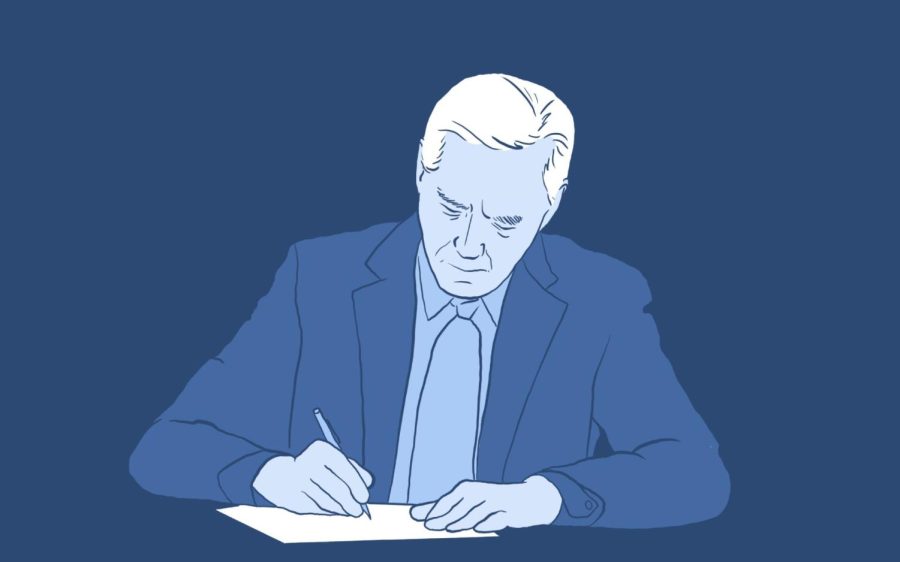The Inflation Reduction Act (IRA), a sprawling piece of legislation that covers many different economic areas, including one of the largest steps taken by the U.S. government to reduce carbon emissions, was signed into law in August 2022.
“About 500 billion in new spending, really targeting clean energy incentives and reduction in healthcare costs, partially offset by an increase in taxes in the corporate sector,” said Seamus Cleary, third year finance and accounting student at Seattle University, about what the bill covers.
The IRA seeks to reduce carbon emissions 40% by 2030 by making the transition to cleaner energy alternatives and encouraging the use of electric vehicles through a $7,000 rebate.
“One little trick is they’re basing 40% on 2005, so some of the reductions already happened,” said DePaul professor and department chair of environmental studies and science Mark Potosnak. “So they’re counting the last 20 years, which emissions haven’t gone down that low, but a good 10% out of that 40%. They’re giving you the 40% number, but already 15% to 20% of that has happened in the past.”
According to Potosnak, while this might be a step in the right direction, it is not enough of a reduction in emissions to drastically reduce or reverse the impacts of climate change.
“Transportation is … about … 30% of our emissions, yet the IRA only has a very small impact on transportation emissions,” Potosnak said.
A large factor of this is that the IRA has only passed legislation that applies to passenger cars.
“Passenger cars are a component, but you have heavy vehicles, trucks, trains, driving freight around, [and] you have a lot of other big sources that aren’t being addressed by the IRA,” Potosnak said.
The transition to clean energy includes slowly replacing nonrenewable energy sources such as coal with renewable sources such as solar and wind power. Some are concerned with the impact this could have on those that rely on those industries for income.
“Anything that transforms the focus of energy production, and alters the way huge amounts of capital are being spent, will alter the lives of the mirror of American citizens, but sometimes for good, sometimes for ill,” said DePaul law professor Gregory Mark. “It will have an impact on those who work in coal fired plants, for example, functionally eliminating their jobs, and whether there will be sufficient employment opportunities in those locales, or retraining opportunities is another kind of question.”
The transition to cleaner energy has been happening far longer than the IRA was signed into law.
“Those industries have been in decline for a while, and I think everyone understands the transition to clean energy is important and where the world is heading,” Cleary said. “So if anything, this might accelerate that process a little bit.”
The IRA also claims to hold corporations accountable for paying their fair share of taxes by getting rid of loopholes, as well as taxing those that earn more than $400,000 per year.
According to Mark, $400,000 is close to the bottom of the top 1% of income earners. While it might be simple to tax individuals, taxing corporations might be tricker for the government.
“The difficulty, of course, with taxing a corporation is that the corporation pays the taxes, but passes along the burden of those taxes to all of its constituencies, so it comes out in the form of higher cost to consumers, lower wages, as well as lower returns on capital to shareholders and others,” Mark said.
According to Cleary, the IRA does not increase taxes enough to majorly impact the average citizen. Tax loopholes are hard to track and will always exist, but the best way to combat them is to pour more funding into the IRS.
“The IRS is an organization that really lacks resources,” Cleary said. “And so I think [if] the administration sees an increase in funding, that’s just a way to really bolster that department’s ability to collect revenue and tax people effectively.”
Part of the IRA that will have the largest impact on everyday citizens is the caps being placed on healthcare costs, such as medication.
“Regarding health care, you know, the health care market is very consolidated, and definitely expensive, and so reducing costs, there will definitely be a big help to the consumer,” Cleary said.
It is still unclear whether the IRA will actually reduce inflation.
“This act provides funds for all kinds of research and development in fields that have been important to the Biden administration and his supporters, as well as whatever efforts it embodies to keep inflation down,” Mark said.
Many aspects of the bill are unrelated to inflation reduction. According to Cleary, the cause of inflation is too complex for the IRA to majorly reduce inflation.
“The reason it’s called the Inflation Reduction Act is because of a compromise within Congress, that it had to not only be revenue neutral, but it had to generate more money than was going to be spent out on these projects over the 10 year lifespan of the legislation,” Potosnak said.
According to Mark, only part of the act actually targets recent inflation, which peaked at around 9% in June 2022 and remains above 5%. The “ideal” inflation rate is 2%.
“Just because something is awkwardly mistitled, doesn’t mean it’s not a good idea,” Mark said.




